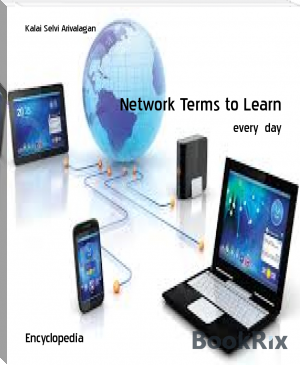Network Terms to Learn, Kalai Selvi Arivalagan [books to read in a lifetime .TXT] 📗

- Author: Kalai Selvi Arivalagan
Book online «Network Terms to Learn, Kalai Selvi Arivalagan [books to read in a lifetime .TXT] 📗». Author Kalai Selvi Arivalagan
Network on a Chip
Network on a chip is a concept in which a single silicon chip is used to implement the communication features of large-scale to very large-scale integration systems. In the case of large-scale designs, network on a chip is preferred as it reduces the complexity involved in designing the wires and also provides a well-controlled structure capable of better power, speed and reliability. For high-end system-on-chip designs, network on a chip is considered the best integrated solution.
Server Consolidation
Server consolidation refers to the use of a physical server to accommodate one or more server applications or user instances. Server consolidation makes it possible to share a server's compute resources among multiple applications and services simultaneously. It is mainly used to reduce the number of servers required in an organization.
Adiabatic Cooling
Adiabatic cooling is a cooling process that provides air cooling by expanding or compressing the pressure of air or a substance. This cooling process changes air pressure without losing or gaining heat.
Activex Control
An ActiveX control is a small program that is used to share information between applications. An ActiveX control can enhance Internet browsing experience by allowing animation and is often compared to Java applets. Microsoft developed the concept in the mid 1990s.
While technically still around technology is no longer commonly used in modern web development.
Teleworking
Teleworking involves the substitution of telecommunications for any kind of work-related travel, that is, without necessarily involving distance restrictions; however, the two terms are often used interchangeably. Teleworking, a broader term for "telecommuting," is more often used in Europe and other countries, whereas "telecommuting" is more often used in the United States and Canada. Both terms often refer to working from home using telecommunications equipment or to the use of mobile telecommunications technology to be able to work from restaurants, coffee shops or other public locations. When distributed work from an employer uses information and communication technologies to replace commuting, it is referred to as telecommuting; when it does not, it is referred to as teleworking. Jack Nilles concocted both terms back in 1973.
Evolutionary Computation
Evolutionary computation is an artificial intelligence subfield and closely linked to computational intelligence, involving lots of combinatorial optimization problems and continuous optimization. It is employed in problem-solving systems that use computational models with evolutionary processes as the key design elements. It is an abstraction from the evolutionary concept in biology since it deals with methods and concepts that are continually and selectively evolving and optimizing.
Tokenization
Tokenization is the act of breaking up a sequence of strings into pieces such as words, keywords, phrases, symbols and other elements called tokens. Tokens can be individual words, phrases or even whole sentences. In the process of tokenization, some characters like punctuation marks are discarded. The tokens become the input for another process like parsing and text mining. Tokenization is used in computer science, where it plays a large part in the process of lexical analysis.
Denormalization
Denormalization is a strategy that database managers use to increase the performance of a database infrastructure. It involves adding redundant data to a normalized database to reduce certain types of problems with database queries that combine data from various tables into a single table. The definition of denormalization is dependent on the definition of normalization, which is defined as the process of organizing a database into tables correctly to promote a given use.
Routing Information Protocol
Routing Information Protocol (RIP) is a dynamic protocol used to find the best route or path from end-to-end (source to destination) over a network by using a routing metric/hop count algorithm. This algorithm is used to determine the shortest path from the source to destination, which allows the data to be delivered at high speed in the shortest time.
Intrusion Prevention System
An intrusion prevention system (IPS) is a system that monitors a network for malicious activities such as security threats or policy violations. The main function of an IPS is to identify suspicious activity, and then log information, attempt to block the activity, and then finally to report it. Intrusion prevention systems are also known as intrusion detection prevention systems (IDPS).
Message Passing Interface
Message Passing Interface (MPI) is a system that aims to provide a portable and efficient standard for message passing. It is widely used for message passing programs, as it defines useful syntax for routines and libraries in different computer programming languages such as Fortran, C, C++ and Java.
B1FF
B1FF is a fictional profile of a USENET poster character that represents a typical "n00b." This fictional teenage character uses his brother's VIC-20 computer to log on and post items that illustrate naïveté and inappropriate use of the forum.
Distro
Distro is IT vernacular for a Linux operating system (OS). It is a shortened version of the term distribution. The singular and the plural (distro vs distros) are often used synonymously.
Blind Drop
A blind drop is a hidden location where a malware program, Trojan or virus drops information gathered from a host. The automatically gathered data remains in that location until it is retrieved by the attacker. The data could be credit card or bank account details, usernames and passwords or any personal information the attacker may use to hack into the host's accounts. It is very hard to detect where data is coming from or where it is going, even if the location is discovered.
Fog Computing
Fog computing is a term for an alternative to cloud computing that puts some kinds of transactions and resources at the edge of a network, rather than establishing channels for cloud storage and utilization. Proponents of fog computing argue that it can reduce the need for bandwidth by not sending every bit of information over cloud channels, and instead aggregating it at certain access points, such as routers. This allows for a more strategic compilation of data that may not be needed in cloud storage right away, if at all. By using this kind of distributed strategy, project managers can lower costs and improve efficiencies.
Radial Basis Function Network
A radial basis function network is a type of supervised artificial neural network that uses supervised machine learning (ML) to function as a nonlinear classifier. Nonlinear classifiers use sophisticated functions to go further in analysis than simple linear classifiers that work on lower-dimensional vectors. A radial basis function network is also known as a radial basis network.
Splay Tree
A splay tree is a self-adjusting tree algorithm that can be used in machine learning and other types of projects. As a binary search tree, the splay tree is a tool for building analytics and big data processes.
Data Transmission
Data transmission is the process of sending digital or analog data over a communication medium to one or more computing, network, communication or electronic devices. It enables the transfer and communication of devices in a point-to-point, point-to-multipoint and multipoint-to-multipoint environment. Data transmission is also known as digital transmission or digital communications.
MongoDB
MongoDB is a cross-platform and open-source document-oriented database, a kind of NoSQL database. As a NoSQL database, MongoDB shuns the relational database’s table-based structure to adapt JSON-like documents that have dynamic schemas which it calls BSON. This makes data integration for certain types of applications faster and easier. MongoDB is built for scalability, high availability and performance from a single server deployment to large and complex multi-site infrastructures.
Machine-Generated Data
Machine-generated data is information that is the explicit result of a computer process or application process, created without human intervention. This means that data manually entered by an end user are definitely not considered to be machine generated. These data cross all sectors which make use of computers in any of their daily operations, and humans increasingly generate this data unknowingly, or at least cause it to be generated by the machine.
Quantile Normalization
Quantile normalization is a data handling technique that works on microarrays or small data sets. This statistical process can be used as the basis for some types of machine learning projects.
Interactive Voice Response (IVR)
Interactive voice response (IVR) is a technology that allows humans to interact with computers using voice or a dual-tone multifrequency (DTMF) signaling keypad. IVR allows customers to find answers to their own inquiries by speaking (using the company’s speech recognition software) or giving inputs via a telephone keypad. IVR uses prerecorded and dynamically generated audio to interact with customers. The key benefit to IVR systems is that they can handle large volumes of calls, where only simple interactions are required. IVR is also known as a telephone menu or voice response unit.
C Drive (C:)
The C drive (C:) is the main hard disk partition which contains the operating system and the related system files. In Windows operating systems, the C drive as represented as “C:”, the backlash representing the root directory of the drive. The C drive is considered as the primary hard drive of the system and is used for storing the operating system, system files and other applications and their related files. In later Windows version, the C: drive is labeled as Primary Drive or Local Disk, and can be accessed by default by opening the “My Computer” folder.
Cloud Storage
Cloud storage is a cloud computing model in which data is stored on remote servers accessed from the internet, or "cloud." It is maintained, operated and managed by a cloud storage service provider on a storage servers that are built on virtualization techniques. Cloud storage is also known as utility storage – a term subject to differentiation based on actual implementation and service delivery.
Digital Divide
The digital divide refers to the difference between people who have easy access to the Internet and those who do not. A lack of access is believed to be a disadvantage to those on the disadvantaged side of the digital divide because of the huge knowledge base that can only be found online.
Symmetric Encryption
Symmetric encryption is a form of computerized cryptography using a singular encryption key to guise an electronic message. Its data conversion uses a mathematical algorithm along with a secret key, which results in the inability to make sense out of a message. Symmetric encrpytion is a two-way algorithm because the mathematical algorithm is reversed when decrypting the message along with using the same secret key. Symmetric encryption is also known as private-key encryption and secure-key encryption.
One-Time Password
A one-time password (OTP) is type of password that is valid for only one use. It is a secure way to provide access to an application or perform a transaction only one time. The password becomes invalid after it has been used and cannot be used again.
Multithreading
Multithreading is a CPU (central processing unit) feature that allows two or more instruction threads to execute independently while sharing the same process resources. A thread is a self-contained sequence of instructions that can execute in parallel with other threads that are part of the same root process. Multithreading allows multiple concurrent tasks can be performed within a single process. When data scientists are training machine learning algorithms, a multithreaded approach to programming can improve speed when compared to traditional parallel multiprocessing programs.
Even though it’s faster for an operating system (OS) to switch between threads for an active CPU task than it is to switch between different processes, multithreading requires careful programming in order to avoid conflicts caused by race conditions and deadlocks. To prevent race conditions and deadlocks, programmers use locks that prevent multiple threads from modifying the value of the same variable at the same time.
Flash Storage
Flash storage describes any type of long-term storage repository supported by flash memory. Flash storage may also be referred to as solid state storage. Unlike traditional hard disk drive storage, flash storage has no mechanical parts which makes it a good choice for storage in mobile technology. Flash storage comes in a variety of formats and prices, ranging from inexpensive consumer-grade USB drives to enterprise-level all flash arrays.
Fixed Wireless Access (FWA)
Fixed wireless access (FWA) is an alternative way for an Internet Service Provider (ISP) to provide small businesses and homes with last mile connectivity. Fixed Wireless Access uses radio waves to create a connection between a Point-of-Presence cell tower and an external antenna located





Comments (0)